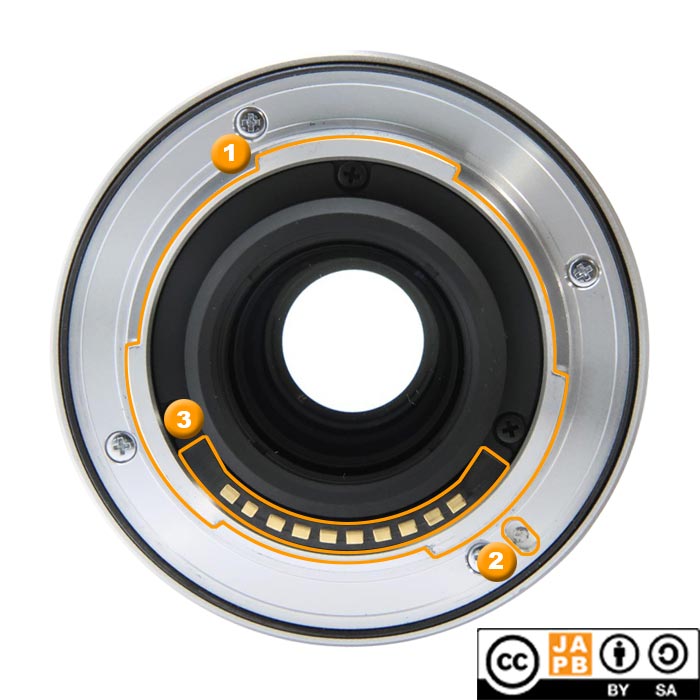Pekka Buttler, (Updated 5/2025)
The Fujifilm X mount is the lens mount used by Fujifilm for its series of APS-C mirrorless cameras and should not be mistaken for the Fujica X mount (that Fuji used for its 1970s-80s film SLR cameras).
Fujifilm X mount specifications and identification
Mount type: Bayonet mount (lens release on camera)
Flange focal distance: 17,70 mm
Film format: 23,6mm x 15,6 mm (APS-C)
Mount communication:
• focusing, aperture command & control (body-to-lens) focusing distance, lens information (lens-to-body), using 10 electronic contacts

[1] Three-pronged male bayonet. All edges straight.
[2] Locking groove at 04:30
[3] 10 electronic contacts (spring-loaded at the camera-end) between 04:30 and 07:30.
(There are fully manual Fujifilm X lenses that do not offer electronic contacts)
Basic Information on the Fujifilm X mount:
Fujifilm is no new entrant into the photographic industry. On the contrary, Fujifilm has an almost century long history in the business. Moreover for more than half a century Fujifilm been a strong player in both cameras (from compacts to medium and large format gear), lenses and (surprise!) film. However , as discussed in more detail in the JAPB article on the Fujica X mount, Fujifilm decided to withdraw from the business of making interchangeable lens cameras for 35 mm film (the consumer segment) in 1985 and thereafter focused on film, compacts and medium format (and larger) cameras.
After the advent of digital photography Fujifilm largely kept its cool. Fujifilm compacts were replaced by digital point-and-shoot cameras, while the pro-segment remained solidly film-based. Notwithstanding a dalliance with repurposing Nikon film and digital bodies and selling these as Fuji FinePix Sx Pro cameras, Fuji kept resolutely away from any prosumer/enthusiast interchangeable lens digital cameras.
That all changed in January 2012 with the introduction of the Fujifilm X-Pro1 mirrorless, rangefinder-style camera and the Fujifilm X mount. The lineup of Fujifilm X mount cameras today is prodigious, including both rangefinder-style, SLR-style and retro-style mirrorless cameras. All these cameras utilise the Fujifilm X mount, use an APS-C size X-trans patterns sensors.
Adapting Fujifilm X lenses
The only camera bodies that is physically able to accommodate Fujifilm X lenses are Nikon Z bodies. Moreover, dumb adapter rings exist, so as long as you Fujifilm X lens has manual focus and manual aperture control, those lenses can be successfully adapted to Nikon Z bodies.
As Fujifilm X lenses are designed to have an image circle to cover the APS-C sensor, it might be necessary to set the Nikon Z camera to capturing only the APS-C area.
Adapting to Fujifilm X bodies
With the short flange focal distance of 17,70 mm (0,3 mm shorter that Sony FE), there are few physical limitations to what legacy lenses you can adapt to Fujifilm X bodies. Basically, there are only few limitations:
Obviously you’ll need some form of adapter (but even a conservative person as myself has freelensed with the mirrorless body (when lacking an adapter)).
Secondly, you’ll need a lens that has a native flange focal distance greater than 17,70 millimetres, but with the exception of some 8 mm and 16 mm (motion picture) film camera mounts (C-mount, CS-mount, D-Mount), many industrial&X-ray mounts and some other mirrorless mounts, that hurdle is not difficult to surmount.
Third, unless you want to manually have to crop every shot in post, you’ll need a lens that produces an image circle that reaches the APS-C sensor area. Beyond those already excluded by the flange focal distance requirement, only the Pentax-110 system, the Olympus Pen-F system and a number of video camera systems can pose issues (even then many lenses will have a sufficient image circle).
Finally, there are some modern lenses that pose limitations because those lenses are too dependent on electronics. This obviously applies to any lens where the aperture mechanism is electronically controlled, or that do not offer any affordance for manual focusing. In order to be able to use such a lens, you will need a compatible smart adapter that will facilitate two-way electronic communication between the body and adapted lens. On the other hand, should you have such an adapter (and should it support the lens in question), it works as a native lens would.
Moreover, when adapting legacy SLR lenses to Fujifilm X cameras, you might want to consider whether you’d prefer using a speed booster adapter to decrease the crop factor.